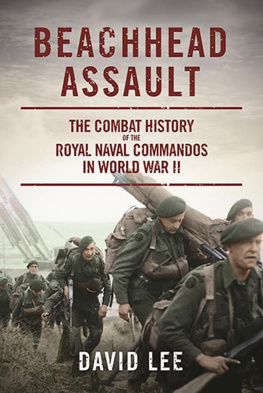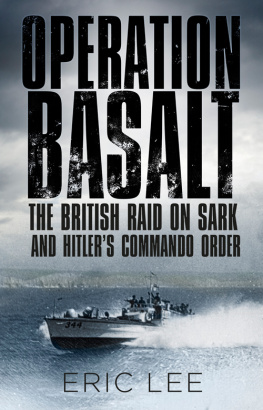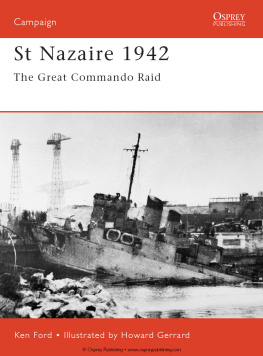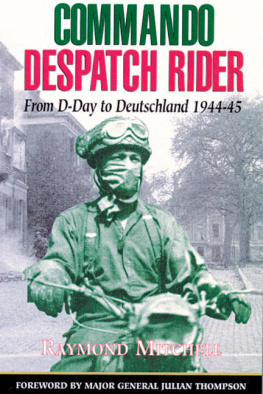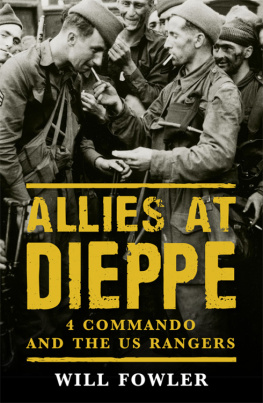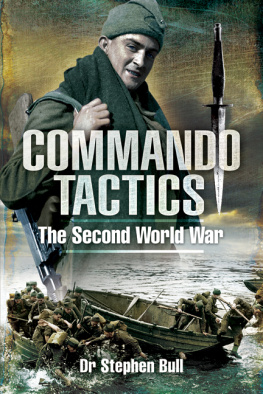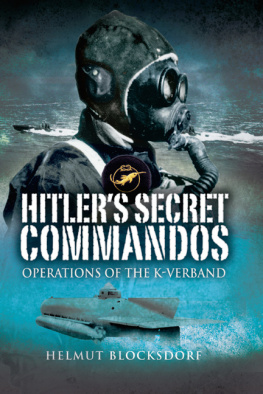Also by Nick van der Bijl:
Argentine Forces in the Falklands (Osprey)
Royal Marines 19391993 (Osprey)
Nine Battles to Stanley (Leo Cooper)
Brean Down Fort and the Defence of the Bristol Channel (HawkEditions)
5th Infantry Brigade in the Falklands (Leo Cooper)
No. 10 (Inter-Allied) Commando 19421945 (Osprey)
Victory in the Falklands (Pen & Sword Military)
Confrontation (Pen & Sword Military)
First published in Great Britain in 2008 by
PEN & SWORD MILITARY
An imprint of
Pen & Sword Books Ltd
47 Church Street
Barnsley
South Yorkshire
S70 2AS
Copyright Nick van der Bijl, 2008
ISBN 978-1-84415-790-7
eISBN 978-1-84468-640-7
PRC ISBN 978-1-84468-641-4
The right of Nick van der Bijl to be identified as Author of this work has been
asserted by him in accordance with the Copyright, Designs and Patents Act 1988.
A CIP catalogue record for this book is
available from the British Library
All rights reserved. No part of this book may be reproduced or transmitted in
any form or by any means, electronic or mechanical including photocopying,
recording or by any information storage and retrieval system, without
permission from the Publisher in writing.
Typeset by Concept, Huddersfield, West Yorkshire
Printed and bound in England by Biddles Ltd
Pen & Sword Books Ltd incorporates the Imprints of Pen & Sword Aviation,
Pen & Sword Maritime, Pen & Sword Military, Wharncliffe Local History,
Pen & Sword Select, Pen & Sword Military Classics, Leo Cooper,
Remember When, Seaforth Publishing and Frontline Publishing
For a complete list of Pen & Sword titles please contact
PEN & SWORD BOOKS LIMITED
47 Church Street, Barnsley, South Yorkshire, S70 2AS, England
E-mail:
Website: www.pen-and-sword.co.uk
Contents
Appendices
List of Maps
Acknowledgements
No. 10 (Inter-Allied) Commando was a unique unit of exiles brought together to form a Commando at a time when the Army was looking everywhere to replace its casualties and those locked up in prison camps. The national contingents each had their own characteristics and yet when they were committed to battle, they each had a single cause liberate their countries, although the Poles wanted to defeat Nazism so they could get at the Russians. The Commando was part of the British Army in every way and was represented at Dieppe, in Italy and the Far East, on D-Day, at Arnhem, Walcheren and the advance through Germany, quite apart from raiding Norway and France. Most were parachute-trained. No other Commando was so widely deployed and yet it functioned as a unit just twice. Its existence spawned Allied commandos in Belgium, France and the Netherlands post-1945.
It is a pleasure to thank those who have helped with this project. The first must be Ian Dear, who wrote the first book on these exiles 10 Commando. He allowed me unrestricted access to his mass of information held in the Imperial War Museum, which then allowed me to add flesh to the story. Mrs Wiet Harpur-Rymakers translated accounts from the Dutch. Mr Wybo Boersma helped me with the Dutch in the Far East and at Arnhem. Colin Anson, Brian Grant and the later Peter Masters gave me steerage with 3 Troop, as did the Jewish Museum, and Pierre-Louis Marichal told me of the relationship between the Belgian Troop and the Belgian SAS. Ivar Kraglund helped with the Norwegians, in particular the provision of photos, as did the Sikorsky Institute in London with the Poles. As always, the Internet provided a massive source of information.
I must also complement the staff of Burnham-on-Sea's Library, who managed to obtain some obscure books that I suspect had not seen the light of day for decades.
I am most grateful to Brigadier Henry Wilson, the Commissioning Editor, for giving me the opportunity to complete another ambition that first emerged when I was serving with the Intelligence Corps in West Germany. I am indebted to Bobby Gainher for editing this project. John Noble, once again, was meticulous in indexing. I must also thank Noel Sadler for typesetting this book in a meticulous manner.
My wife, Penny, has once again been a mountain of patience in not only supporting me but also proofreading and asking all the right questions.
Nick van der Bijl
Somerset
Glossary
AbwehrAmt Ausland/Abwehr im Oberkommando der Wehrmacht (Overseas Department/Office in Defence of the Armed Forces High Command). Military Intelligence organization concentrating on human intelligence.
BBO Bureau Bijzondere Opdrachten (Bureau of Special Operations).
Bren Gun Standard infantry .303-inch light machine gun with a distinctive curved thirty-round magazine. Development of the Czech ZB33 and could fire out to 2,000 yards.
CIGS Chief of the Imperial General Staff.
CO Commanding Officer.
DD Duplex Drive. Fitted with equipment that enabled tanks to be amphibious.
DSO Distinguished Service Order.
DUKWD (designed in 1942) U (utility) K (all-wheel drive) W (two powered rear axles). Six-wheel-drive amphibious truck.
FNFLForces Navales Francaises Libre (Free French Naval Forces).
GHQ General Headquarters.
Goatley Lightweight collapsible assault boat with a wooden bottom and canvas sides carrying seven men, with six paddling. Could be assembled by two men in about ninety seconds, most suited to river crossings.
GS(R) General Staff (Research). War Office department studying irregular warfare.
LCA 13-ton Landing Craft Assault that could land thirty-five troops over a ramp and lift an additional 800lb of equipment up to 80 miles at 7 knots. Usually crewed by four Royal Navy or Royal Marines, its wooden sides were protected by armour.
LCI(S) Landing Craft Infantry (Small). A 110-ton wooden landing craft based on a MGB and fitted with silenced petrol engines, they were designed for long-distance voyages and could carry 102 fully equipped troops and their equipment, such as PIAT anti-tank weapons and eighteen bicycles, and had a naval crew of seventeen. In addition to Embarked Force weapons, it was armed with two 20mm cannon and two Lewis guns.
LCP(L) 9-ton Landing Craft Personnel (Large). Could carry twenty-five troops about 120 miles at 8 knots. Crewed by three and armed with up to medium machine-guns; disembarkation was the troops jumping from the bow.
LSI Landing Ships Infantry.
MC Gallantry award issued to officers.
MFC Marine Fusilier Commando Battalion.
MGB 95-ton Motor Gun Boat with a maximum speed of 28 knots. Equipped with two power-mounted, turreted 6-pdrs fore and aft, an aft twin 20mm Oerlikon, a single 20mm forward of the bridge and two twin .303-inch Vickers on the bridge wings.
MI5 Military Intelligence 5 Security Services.
MI(R) Military Intelligence (Research). War Office department studying use of small raiding forces.
MM Military Medal. Gallantry award for non-commissioned ranks.
Mouseholing Using explosives on a portable frame to blow holes in walls of buildings.
NAAFI Navy, Army and Air Force Institute.
NBS Netherlands Binnenelandsche Strijdrachten (Netherlands Forces of the Interior).
NCO Non-Commissioned Officer. From Lance Corporal to Staff/Colour Sergeant and equivalent.
NSO Netherlands Special Operations.
OBE Order of the British Empire.
OCTU Officer Cadet Training Unit.
PIAT Projectile Infantry Anti-Tank. Portable anti-tank weapon weighing a cumbersome 34lb and firing a 2lb bomb out to 100 yards. Effective out to 350 yards when mounted on its bipod against buildings.
Next page




